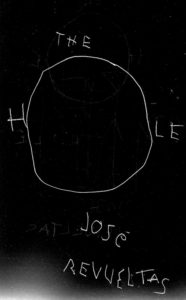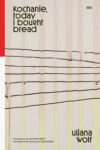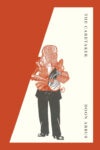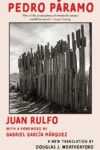 [New Directions; 2018]
[New Directions; 2018]
Tr. from the Spanish by Sophie Hughes and Amanda Hopkinson
From late 1968 to early 1971, the writer and political activist José Revueltas was imprisoned in Mexico City’s notorious Lecumberri Penitentiary, accused of being the “intellectual author” of the largest student movement in the country’s history. It wasn’t his first time in jail. As a teenager, he served six months in a correctional facility for participating in a protest, and in his thirties, he was twice arrested for Communist activities and shipped to the Islas Marías, a Mexican penal colony in the Pacific Ocean. In an April 1969 entry in his Lecumberri prison diary, Revueltas wrote that “in the contemporary world . . . an invisible web of fictions surround us, and we struggle as prisoners inside it.” He was likely alluding to the “web of fictions” that the Mexican government had spun in order to avoid responsibility for the infamous 1968 massacre in Tlatelolco Square. Yet the lines are clearly freighted with a deeper symbolic weight. Midway through his fifth stint in prison, Revueltas had begun to view the carceral system as the most appropriate metaphor for modern life.
It was during his last period of incarceration, in February and March of 1969, that Revueltas composed his most important literary work, The Hole. The short novel, available this month for the first time in English in an excellent translation by Amanda Hopkinson and Sophie Hughes, consists of a single paragraph of slightly more than fifty pages. It takes place in the maximum-security wing of an unnamed prison closely resembling Lecumberri. We first see the prison from the vantage point of a young inmate, Polonio, who shares a small isolation cell (the “hole”) with two other men, Albino and The Prick. The three men’s only access point to the world is a small hatch on the door of their cell, from which they take turns peering out at the prison guards pacing the atrium below. In many ways, the novel is a study of how extreme confinement warps the human psyche. But in the opening paragraphs, in the first of many narrative twists, Revueltas reveals that the prison guards are even “more captive” than the prisoners themselves, bound as they are by their own dehumanizing routine of punishing for pay. The first part of the novel—a mixture of Polonio’s thoughts and the narrator’s commentary on those thoughts—details each grotesque feature of the guards’ alienated labor, from their repetitive routes through the prison’s corridors to the small bribes they extract for their families back at home. Life for these guards “is one long not knowing…that they were in their cage.” It’s hard to miss the ideological thrust of these pages. A society that brutalizes its prisoners is bad. A society that treats everyone like a prisoner is worse.
Although Revueltas was a committed Marxist throughout his life, The Hole is not a political novel in the ordinary sense. Its main characters are common criminals, and its plotline is simple and sordid: the three inmates in the hole convince three female visitors to help them smuggle drugs into the prison’s maximum-security wing. As Álvaro Enrigue observes in his superb introduction to the English edition, the novel unfolds in real time: through multiple perspectives, it tracks the attempted handoff of the drugs from the moment the women enter the prison until they finally reach the inmates in the hole. The richness of the text, though, resides in how Revueltas layers this relatively straightforward chronology with figurative meaning. The characters’ actions are variously imbued with religious allegory, biological metaphor, Freudian fantasy, and the symbology of class struggle. Looming over every deed and desire in the novel is the threat of sudden, irrepressible violence. Polonio casually reflects on his intention to kill The Prick once the drugs are delivered; the two young women, Meche and La Chata, submit to a body search by the female guards that includes a long lascivious cavity check—one that gives them an uncomfortable and unexpected erotic charge. At one point the narrator refers to Meche’s mind as an “archeology of passion, emotion, and sin.” It’s an apt description of the confusion that all of the characters experience in The Hole.
In translating Revueltas’s novel, Hopkinson and Hughes have produced an eloquent and highly readable English version. That’s no small feat. In the original Spanish, The Hole is notoriously dense. As many commentators have observed, the physical appearance of the text seem to imitate the form of the prison itself: a single block of writing with no paragraph breaks and few periods. Once you start the novel, you are essentially locked in. Additionally, the novel constructs an intricate network of linguistic connections ranging from biblical allusions to vernacular idioms. In the very first sentence, for instance, there is a pun on the word mono, which literally means “monkey,” but also refers to a prison guard in Mexican slang. In the original, Revueltas plays on this double meaning repeatedly, first by alluding to the fact that the guards are trapped like monkeys (monos en su jaula), then by suggesting that they are a kind of regression back down the evolutionary scale (a common phrase in Spanish is “we all descend from monkeys.”) The twin meanings of the word are obviously impossible to duplicate in English. Here and elsewhere, Hopkinson and Hughes opt for legibility over absolute fidelity. Instead of inserting a footnote, or attempting their own play on words, they translate mono as “ape,” thus underscoring the Darwinian connection and accentuating the inhumane treatment of the guards. Of course all of this work passes under the radar screen of the English-language reader, but it contributes to making The Hole a fluid, fast-paced read. For those who want more information on the language, sociology and history of the Mexican prison, Enrigue’s introduction serves as helpful guide.
For many years, Revueltas’s works remained relatively unknown to the broader Mexican reading public because of his reputation as an “extreme” leftist militant. Although he was expelled from the Mexican Communist Party in the early sixties for his critique of party leadership, the Cold War logic of canonization kept him on the margins of the national tradition. Over the past decade, Revueltas has enjoyed something of a revival, sparked in part by the 2014 reissue of his complete works on the hundredth anniversary of his birth. Yet he has always had a strong underground influence in Mexico. His political writings of the 1960s and 1970s marked a turning point in Mexican intellectual history: his critique of the Stalinist orthodoxy, coupled with his support of the student movement’s platform of participatory democracy, made him a key figure in the Mexican version of what we in the states call the New Left. His literary production of that period marked a similar transition. His most famous early novel, Human Mourning, exhibits a romantic fascination with death, religion, and the aftermath of the Mexican Revolution that places it firmly in the line running from Martin Luis Guzmán’s The Shadow of the Strongman to Octavio Paz’s The Labyrinth of Solitude, Juan Rulfo’s Pedro Páramo, and Carlos Fuentes’s The Death of Artemio Cruz. But The Hole, with its singular combination of oneiric horror and documentary realism, helped to galvanize a new cultural sensibility. It’s no coincidence that Elena Poniatowska read The Hole and visited Revueltas in his Lecumberri cell while composing her nightmarish testimonial Massacre in Mexico, perhaps the most famous book ever written about Tlatelolco. That legacy has continued. Roberto Bolaño’s Amulet, a short novel that depicts the events of 1968 with a similar blend of fantasy and realism, springs directly from a Revueltian aesthetic.
The publication of The Hole in English coincides with the fiftieth anniversary of the student movement. In Mexico, this has been a momentous year. In July, the country elected its first left-leaning president in decades, one who has vowed to eliminate the use of military force against its civilian population. And on October 2, the anniversary of the Tlatelolco massacre, Mexican authorities approved the placement of a sign in Zócalo Square that says what Revueltas and others had been saying all along: fue el estado, the state did it. Beyond its historical significance in relation to 1968, though, Revueltas’s novel speaks to the ongoing problems of our contemporary world. The escalation of violence in Mexico over the past decade has not only taken place in the streets but also in jail, where prisoners are regularly threatened, beaten and disappeared with almost complete impunity. And the United States, which currently imprisons more of its citizens than any other country in the world, has an equally shameful history of carceral mistreatment. In the last interview he gave during his lifetime, Revueltas remarked, “For me, the prison bars in The Hole are the prison bars of the city and the prison bars of the country and the prison bars of the world.” That is arguably truer today than it was when he wrote the novel fifty years ago. The appearance of The Hole won’t alter that fact. But it will give English-language readers a different view of its dimensions, both in reality and in terms of the collective web of fictions we weave.
Jeffrey Lawrence is Assistant Professor of English at Rutgers University, where he teaches modern U.S. and Latin American literature and culture. He is the author of Anxieties of Experience: The Literatures of the Americas from Whitman to Bolaño (Oxford, 2018) and the translator of Andrés Neuman’s How to Travel Without Seeing: Dispatches from the New Latin America (Restless, 2016). He is a founding contributor to the online blog of literary reviews El Roommate: colectivo de lectores, and he currently serves as the research director for The Mastheads, a public humanities project in Pittsfield, Massachusetts.
This post may contain affiliate links.







